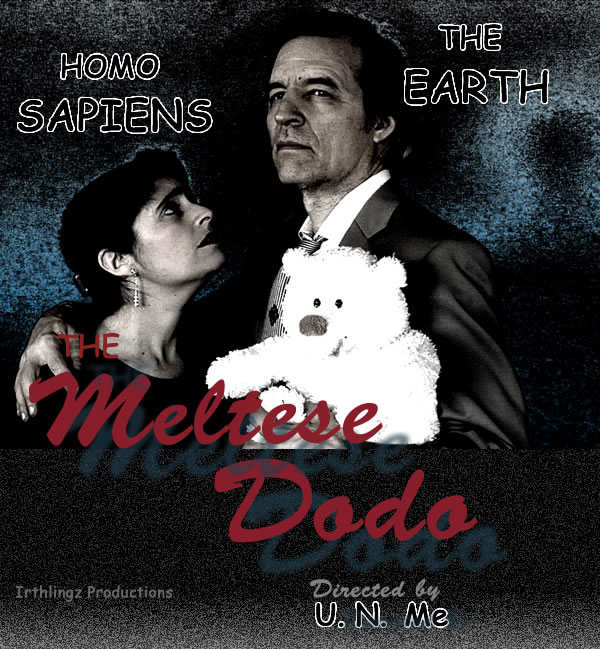
It’s a slow millennium at T.E. Detective Agency …
 … when the beautiful Homo sapiens turns up with a desperate plea for help: Someone is putting the heat on The Environment, the psycho serial mass-murderer that’s been in the papers so much lately. And The Environment is hitting back – hard. Now it seems The Environment is gunning for Homo sapiens, and the species wants our hardboiled detective hero, The Earth, to “get something” on The Environment that will give Homo sapiens the upper hand. The Earth has a fever and there’s a lot about the whole story that smells “like methane meandering through melting Alaskan tundra.” But looking into her big, sparkling, sad, intelligent eyes, full of imagination, love and poetry – “the kind of species you’d hate to lose” – he takes the case.
… when the beautiful Homo sapiens turns up with a desperate plea for help: Someone is putting the heat on The Environment, the psycho serial mass-murderer that’s been in the papers so much lately. And The Environment is hitting back – hard. Now it seems The Environment is gunning for Homo sapiens, and the species wants our hardboiled detective hero, The Earth, to “get something” on The Environment that will give Homo sapiens the upper hand. The Earth has a fever and there’s a lot about the whole story that smells “like methane meandering through melting Alaskan tundra.” But looking into her big, sparkling, sad, intelligent eyes, full of imagination, love and poetry – “the kind of species you’d hate to lose” – he takes the case.
To get all the facts about heat and The Environment, The Earth will turn to “life forms I’ve known for millions of years: bacteria, yeasts, molds, guys like that.” He will journey through France, England, Scotland, Ireland, the United States and way beyond, seeking out a series of “reliable sources” from algae to the Sun, Mercury and Venus.Homo sapiens follows to “help”, and has encounters (usually unfortunate either for her, someone else in the vicinity, or both) with a stinging jellyfish, a terrifying mouse, a bag of organic whole wheat flour, coal-fired steam engines, an exhausted salmon, a river lacking a factory and a nuclear power plant, a lawn in need of fertilizer, several hundred fishhook water fleas, a fishing net, and ultimately with The Earth himself.
Often, The Earth’s “reliable sources” are only too glad to brag about their heroically scientific countrymen. And sometimes, they seem to be holding out, and he has to get tough to get them to “spill”.
Ominously, all the major figures connected with the case appear to have ended up on a slab: Joseph Fourier, the first to realize that the atmosphere acts as a blanket around the planet; William Herschel, discoverer of infrared light; James Watt, father of the Industrial Revolution; John Tyndall, who first showed which atmospheric gases trap heat and keep the planet warm. But if someone is trying to intimidate the intrepid investigator, that’s not going to happen. (“Well, okay, I’m trembling. I’m shaking like spacetime when two supermassive black holes merge. And I’m still not quitting.”)
The story that begins to emerge from these sources seems incredible, far-fetched: dark heat, invisible light trapped by unseen gases. The Earth isn’t buying it. (“Don’t give me invisible gas!”) The trail of deaths seems too long to be merely coincidental. (“Maybe his theory of heat was a little too hot for someone’s comfort? And that someone decided to cool it off – permanently.”)
Ultimately, he can’t deny the hard truth: He has to confront Homo sapiens …
